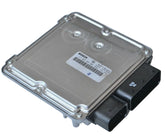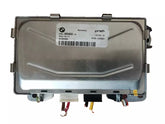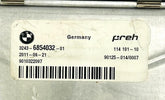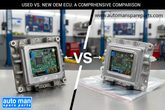Finding Parts for Obsolete Vehicles: A Classic Car Enthusiast's Guide
Are you struggling to find those elusive parts for your beloved classic car? You're not alone. Many enthusiasts face this challenge when restoring or maintaining vehicles that manufacturers stopped supporting years ago. Whether you're working on a vintage Mustang, a classic Chevy, or a rare foreign model, this guide will help you track down those hard-to-find components while avoiding common pitfalls.
Table of Contents
- Why Finding Obsolete Vehicle Parts Is Challenging
- How to Research and Identify the Exact Parts You Need
- Top Sources for Finding Rare and Discontinued Parts
- Online Communities and Resources for Classic Car Enthusiasts
- When to Consider Reproduction Parts vs. Original Components
- Tips for Verifying Part Compatibility and Authenticity
- DIY Solutions: When to Make Your Own Parts
- Professional Services for Obsolete Vehicle Components
- Future-Proofing Your Classic Car Maintenance
Why Finding Obsolete Vehicle Parts Is Challenging
The hunt for obsolete vehicle parts can feel like searching for buried treasure. When manufacturers discontinue a vehicle line, they eventually stop producing replacement parts. Sometimes, these companies even destroy the original tooling, making it impossible to create exact replicas.
The challenge grows when dealing with vehicles from defunct brands like Pontiac, Saturn, or international marques with limited US presence. Additionally, original equipment manufacturers (OEMs) typically support vehicles for only 10-15 years after production ends, leaving owners of older classics to fend for themselves.
Another hurdle is proper identification. Unlike modern vehicles with standardized part numbering systems, older vehicles often have inconsistent documentation. A single component might have been modified multiple times during a production run without clear records of these changes.
How to Research and Identify the Exact Parts You Need
Before starting your search, arm yourself with precise information:
Gather your vehicle's documentation: Locate your owner's manual, service manual, and parts catalog. Original factory literature is gold for accurate part numbers and specifications.
Decode your VIN: Your vehicle identification number reveals crucial details about your car's original build, including engine type, model year, and factory options.
Document the existing part: Before removing any component, photograph it from multiple angles. Measure its dimensions and note any identifying marks, casting numbers, or other unique features.
Consult model-specific resources: Many classic cars have dedicated books, websites, and forums with detailed parts information. These can help you identify components even when original documentation is missing.
Find cross-references: Many parts were used across different models or years. Learning these cross-references expands your search options significantly.
Top Sources for Finding Rare and Discontinued Parts
When hunting for obsolete parts, diversify your search across these reliable sources:
Specialized parts suppliers: Many businesses focus exclusively on specific makes or eras. These specialists often have extensive inventories of new old stock (NOS) parts and reproduction components.
Salvage yards and auto recyclers: Don't overlook junkyards, especially those specializing in vintage vehicles. Many maintain searchable databases of their inventory, making it easier to locate specific parts.
Swap meets and car shows: These events attract sellers with rare components that never appear online. Build connections with vendors who might keep an eye out for parts you need.
Online marketplaces: Beyond the obvious platforms like eBay Motors, explore specialty sites like Hemmings, ClassicCars.com, and model-specific trading forums.
International sources: Parts for American classics might be more readily available overseas, where different usage patterns led to different supply situations. Similarly, parts for foreign classics might be easier to find in their countries of origin.
Online Communities and Resources for Classic Car Enthusiasts
The classic car community offers invaluable support for parts hunting:
Model-specific forums: These online communities often maintain parts databases, vendor lists, and technical libraries. Members frequently help each other locate rare components.
Social media groups: Facebook groups, Instagram communities, and other social platforms connect enthusiasts across geographic boundaries, expanding your search network.
Clubs and associations: National and regional car clubs maintain parts registries, technical archives, and vendor relationships that can prove invaluable.
Registry websites: Many rare models have dedicated registries that track existing examples and maintain parts inventories or knowledge bases.
The collective knowledge within these communities often reveals sources and solutions that you'd never discover on your own.
When to Consider Reproduction Parts vs. Original Components
Deciding between original and reproduction parts involves several considerations:
Originality vs. functionality: For show cars and museum-quality restorations, original parts may be essential. For drivers and modified classics, reproductions often offer better performance and reliability.
Availability factors: Some components simply don't exist in original form anymore. Reproduction parts may be your only option besides custom fabrication.
Quality variations: Reproduction parts vary widely in quality. The best reproductions are made with original tooling or reverse-engineered with modern technology for perfect fitment. Budget reproductions may require significant modification to work properly.
Price considerations: Original parts for rare vehicles can command premium prices, often exceeding the cost of quality reproductions. However, for investment-grade restorations, original components typically retain higher value.
Safety components: For critical systems like brakes, steering, and suspension, modern reproductions often incorporate safety improvements over original designs.
Tips for Verifying Part Compatibility and Authenticity
Before purchasing, especially for expensive components:
Request detailed photos: Ask sellers for images showing part numbers, date codes, and manufacturer markings. Compare these against reference materials.
Verify measurements: When specifications are available, confirm that the part's dimensions match what your vehicle requires.
Check return policies: Ensure you can return parts if they don't fit or aren't as described.
Research the seller: Look for vendors with strong reputations in the classic car community. Check reviews and ask for references when dealing with unfamiliar sources.
Beware of counterfeits: Some rare parts, especially for prestigious marques, attract counterfeiters. Educate yourself on how to identify authentic components.
DIY Solutions: When to Make Your Own Parts
Sometimes fabrication becomes the best option:
Simple components: Brackets, spacers, and similar items can often be recreated with basic metalworking skills.
3D printing opportunities: Modern technology allows enthusiasts to create plastic components, prototype parts, and even create molds for casting.
Machine shop services: Local machine shops can reproduce many mechanical components from samples or drawings.
Adaptation strategies: Parts from similar vehicles can sometimes be modified to work in your application.
Fabrication resources: Many restoration books include patterns and instructions for recreating commonly needed parts.
The DIY approach requires patience and sometimes specialized tools, but it can solve problems when no commercial solution exists.
Professional Services for Obsolete Vehicle Components
When parts can't be found or made easily, specialized services offer solutions:
Parts restoration services: Companies exist that rebuild worn components to like-new condition, from carburetors to gauge clusters.
Metal recreation specialists: Skilled metalworkers can reproduce body panels, trim pieces, and structural components that no longer exist.
Remanufacturing services: Some companies will reverse-engineer and produce small batches of discontinued parts when enough demand exists.
NOS part location services: Professional parts finders maintain extensive networks and can often locate components that seem impossible to find.
These services typically cost more than off-the-shelf solutions but can be worth the investment for rare vehicles or crucial components.
Future-Proofing Your Classic Car Maintenance
Smart enthusiasts plan ahead:
Buy spares for wear items: When you find hard-to-locate consumable parts, purchase extras to keep in inventory.
Document your sources: Maintain a record of where you found specific components so you can return when needed.
Support reproduction efforts: Companies considering reproducing rare parts often gauge interest before committing resources. Make your needs known.
Share knowledge: Contributing to community parts databases and forums helps ensure information isn't lost.
Explore modern alternatives: Sometimes, carefully selected modern components can be adapted to classic applications, offering improved reliability and future parts availability.
By taking these proactive steps, you can minimize future parts headaches while enjoying your classic vehicle.
Conclusion
Finding parts for obsolete vehicles requires determination, research skills, and connection to the right communities. While the process can sometimes feel frustrating, the satisfaction of preserving automotive history makes the effort worthwhile. With the strategies outlined in this guide, you'll be better equipped to keep your classic on the road for years to come.
Remember that patience is perhaps your most valuable tool in this journey. The perfect part might take months or even years to find, but persistent searching almost always yields results eventually. In the meantime, build your knowledge, expand your network, and enjoy the treasure hunt that makes classic car ownership such a rewarding adventure.
Ready to Start Your Search?
Browse our specialized inventory of hard-to-find components for classic American and European vehicles. Our team of enthusiasts understands the challenges you face and has curated one of the industry's most comprehensive collections of parts for discontinued models. Contact our parts specialists today for personalized assistance with your specific needs!







